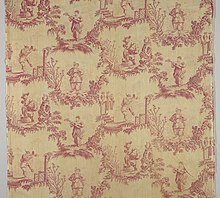Percale

Percale[1] is a closely woven plain-weave fabric often used for bed covers. Percale has a thread count of about 200 or higher and is noticeably tighter than the standard type of weave used for bedsheets. It has medium weight, is firm and smooth with no gloss, and warps and washes very well. It is made from both carded and combed yarns, and may be woven of various fibers, such as cotton, polyester, or various blends.[2]
History[]
Moris or mauris was the 18th century French term used for percale, the cloth imported from India.[3][4] It was a cotton cloth. Moris was the third most exported fabric from Coromandel Coast after Longcloth and Salampore. It was superior and finer quality than the peers. Coromandel coastline forms a part of Tamil Nadu and Andhra Pradesh. Moris was produced at Nellore, Arni, Maduranthakam, and Cuddalore. Palakollu.The cloth was famous as painted chintz in southeast countries also.[5] [6][7][8]
Percale was formerly imported from India in the 17th and 18th centuries,[9] then manufactured in France.[10]
Etymology[]
The word may originate from the Persian pargālah, meaning rag,[11][12] although the Oxford English Dictionary (as of December 2005) has traced it only as far as 18th-century French. The dictionary of the Institut d'Estudis Catalans describes pexal and perxal as some kind of silk fabric in the year 1348 in Valencia.[13] The etymological dictionary of Catalan explains perxal as derived from Perche in France.[14]
In the year 1322 in Dalmatia, which had trade connections also as the Republic of Venice, Peter de genere Percal was mentioned. This word Percal, which occurred the first time in a Supreme Court verdict on Latin in 1322 in Dalmatia, derived from the Hebrew word פרקליט (prklyt), which derived from the Ancient Greek word παράκλητος (parákletos), which means lawyer.[15] The relationship between bedding and law in ancient Persia can be guessed, because according to Phanias of Eresus, Artaxerxes I of Persia had given to Themistocles the city of Percote with bedding for his house.[16]
Taking into account the different spellings of this "generatio Percal" due to the variations Parkly and Perkly in Dalmatia, the name of a farm near Linlithgow Palace in Scotland, which had been built in the 14th century by a first cousin of the grandmother of this Peter de genere Percal, was mentioned in 1431 also as Parkly. This farm was also mentioned as Parkle (1431), Perkley (1432), Parcle (1438), Perkle (1439), Parklye (1440), Parklee (1489), Perklee (1490/91), Parklie (1528), Pairklie (1638), Pairkly (1647) and Parkly (1648) since then and it is mentioned as Parkley since 1671.[17][18][19]
See also[]
- Sateen
- Silk
References[]
- ^ How India clothed the world: the world of South Asian textiles, 1500–1850, volume 4 of Global Economic History series, p. 440, Giorgio Riello, Tirthankar Roy, Om Prakash, published by Brill, 2009, ISBN 978-90-04-17653-9.
- ^ "Fabric Glossary". Dotmaison magazine.
- ^ Wellington, Donald C. (2006). French East India Companies: A Historical Account and Record of Trade. Hamilton Books. p. 223. ISBN 978-0-7618-3475-5.
- ^ Wingate, Isabel Barnum (1979). Fairchild's dictionary of textiles. Internet Archive. New York : Fairchild Publications. p. 378. ISBN 978-0-87005-198-2.
- ^ Arasaratnam, Sinnappah; Arasaratnam, Professor and Head of Department of History Sinnappah; Arasaratnam, Maritime History Scholar and Professor of Indian History S. (1986). Merchants, Companies, and Commerce on the Coromandel Coast, 1650-1740. Oxford University Press. pp. 99, 52, 340. ISBN 978-0-19-561873-0.
- ^ Journal of Indian History. Department of Modern Indian History. 2007. p. 23.
- ^ Amrith, Sunil S. (2013-10-07). Crossing the Bay of Bengal. Harvard University Press. p. 53. ISBN 978-0-674-72846-2.
- ^ How India Clothed the World: The World of South Asian Textiles, 1500-1850. BRILL. 2009-07-31. p. 289. ISBN 978-90-474-2997-5.
- ^ "percale noun" The Oxford Essential Dictionary of Foreign Terms in English. Ed. Jennifer Speake. Berkley Books 1999. Oxford Reference Online. Oxford University Press. Cambridgeshire Libraries. 18 December 2007
- ^ "percale, n. and adj.", Draft Revision Dec. 2005, Oxford English Dictionary
- ^ "percale", The American Heritage Dictionaries, at answers.com
- ^ A comprehensive Persian-English dictionary: including the Arabic words and phrases to be met with in Persian literature, being, Johnson and Richardson's Persian, Arabic, and English dictionary, revised, enlarged, and entirely reconstructed, The World's Most Detailed and Comprehensive Persian-English Dictionary, Francis Joseph Steingass, Asian Educational Services, 1992. ISBN 978-81-206-0670-8
- ^ Diccionari Aguiló: materials lexicogràfics / aplegats per Marià Aguiló i Fuster; revisats i publicats sota la cura de Pompeu Fabra i Manuel de Montoliu, page 134, Institut d'Estudis Catalans, Barcelona 1929.
- ^ Diccionari etimològic i complementari de la llengua catalana: O-Qu.- 1986, cop. 1985.- 977 p, page 464, Joan Corominas, Joseph Gulsoy, Max Cahner, Curial Edicions Catalanes, 1995. ISBN 978-84-7256-276-9
- ^
 The dictionary definition of פרקליט at Wiktionary
The dictionary definition of פרקליט at Wiktionary
- ^ Themistocles, Part II Archived 2015-10-01 at the Wayback Machine, by Plutarch
- ^ Monumenta spectantia historiam slavorum meridionalium, Volume 42, page XIX, Jugoslavenska akademija znanosti i umjetnosti, Academia Scientiarum et Artium Slavorum Meridionalium, 1917.
- ^ The place-names of West Lothian, page 63, Angus Macdonald, Oliver and Boyd, 1941.
- ^ Parkley farm
External links[]
 Media related to Percale at Wikimedia Commons
Media related to Percale at Wikimedia Commons
- Woven fabrics


